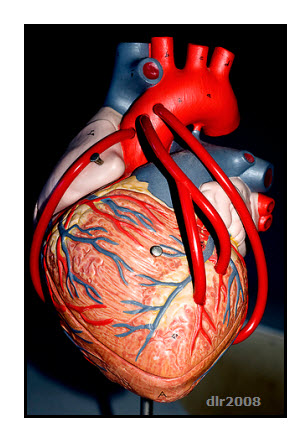Tiny, hollow air-exchange sacs that exist in clusters at the end of each of the air-conducting passageways in the lungs, the bronchioles.
aorta
The enormous artery extending from the heart that receives all the blood pumped by the heart’s left ventricle. Branches stemming from the aorta supply oxygenated blood to all the tissues in the body.
artery
A blood vessel that carries blood away from the heart.
bronchiole
Tiny air-conducting passageway in the lungs that has at its end several alveoli, the hollow air-exchange sacs of the lungs.
capillary
The smallest type of blood vessel, connecting the arteries and veins in the body’s tissues. Gases, nutrients, and wastes are exchanged between the blood and the body’s tissues through the thin walls of capillaries.
cardiovascular system
A fluid transport system of the body, consisting of the heart, all the blood vessels in the body, the blood that flows through these vessels, and the bone marrow tissue in which red blood cells are formed.
connective tissue
A tissue, active in the support and protection of other tissues, whose cells are surrounded by a material that they have secreted. In humans, one of the four principal types of tissue.
coronary artery
An artery that delivers oxygenated blood to the muscles of the heart. Blockage of coronary arteries causes heart attack.
digestive system
The organ system that transports food into the body, secretes digestive enzymes that help break down food to allow it to be absorbed by the body, and excretes waste products. This system consists of the esophagus, stomach, and large and small intestines p
epithelial tissue
A tissue that covers surfaces exposed to an external environment. In humans, skin is an epithelial tissue, as is the lining of the digestive tract.
fatty acid
A molecule, found in many lipids, composed of a hydrocarbon chain bonded to a carboxyl group.
Cells and cell fragments that form the nonfluid portion of blood. Formed elements include red blood cells, white blood cells, and platelets. Contrast with plasma, the fluid portion of blood, consisting mostly of water.
A complete blockage of one of the heart’s coronary arteries, resulting in the death of groups of heart cells from lack of a blood supply.
The iron-containing protein in red blood cells that binds to both oxygen and carbon dioxide, thus assisting in their transportation.
A type of protein that transports fat or lipid molecules (usually cholesterol) from various tissues in the body to the liver. Sometimes known as the “good cholesterol,” HDLs help remove, and possibly neutralize, the LDLs or low-density lipoproteins that c
A substance that, when released in one part of an organism, goes on to prompt physiological activity in another part of the organism. Both plants and animals have hormones.
A molecule composed of both lipid and protein. Lipoproteins transport fat molecules through the bloodstream to all parts of the body.
A type of protein that transports fat or lipid molecules (usually cholesterol) from the liver and small intestine to various tissues throughout the body. Sometimes known as the “bad cholesterol,” LDLs can initiate heart disease by coming to reside within
Tissue that has the ability to contract. In humans, one of the four principal types of tissue.
In humans, the passageway at the back of the mouth that links the mouth with both the food-transporting esophagus and the air-transporting trachea. In some animals, the pharynx can be everted, or turned inside-out, and used to obtain nutrients.
The fluid portion of blood, consisting mostly of water but also containing proteins and other molecules. Contrast with formed elements—the cells and cell fragments that form the nonfluid portion of blood.
One of the three varieties of formed elements within blood, platelets are small fragments of cells that facilitate blood clotting by releasing clotting enzymes and clumping together at the site of an injury.
The system that circulates blood between the heart and the lungs. This system brings oxygen into and takes carbon dioxide away from the body.
The blood cells, also known as erythrocytes, that transport oxygen to and carry carbon dioxide from every part of the body.
The organ system that brings oxygen into the body and expels carbon dioxide from the body. In humans, this system includes the lungs and passageways that carry air to the lungs.
One of the body’s two general networks of blood vessels that serves to transport blood between the heart and the rest of the body following oxygenation of this blood in the body’s pulmonary circulation.
The organ system that eliminates waste products from the blood through formation of urine. In humans, this system consists of the kidneys, where the urine is formed; and the ureters, urinary bladder, and urethra, which transport the urine from the kidneys
A blood vessel that carries blood toward the heart.
A blood vessel that carries blood toward the heart.
The central cells of the immune system. Types of white blood cells include T cells, B cells, neutrophils, eosinophils, and macrophages, each playing a specific role in immune responses.
